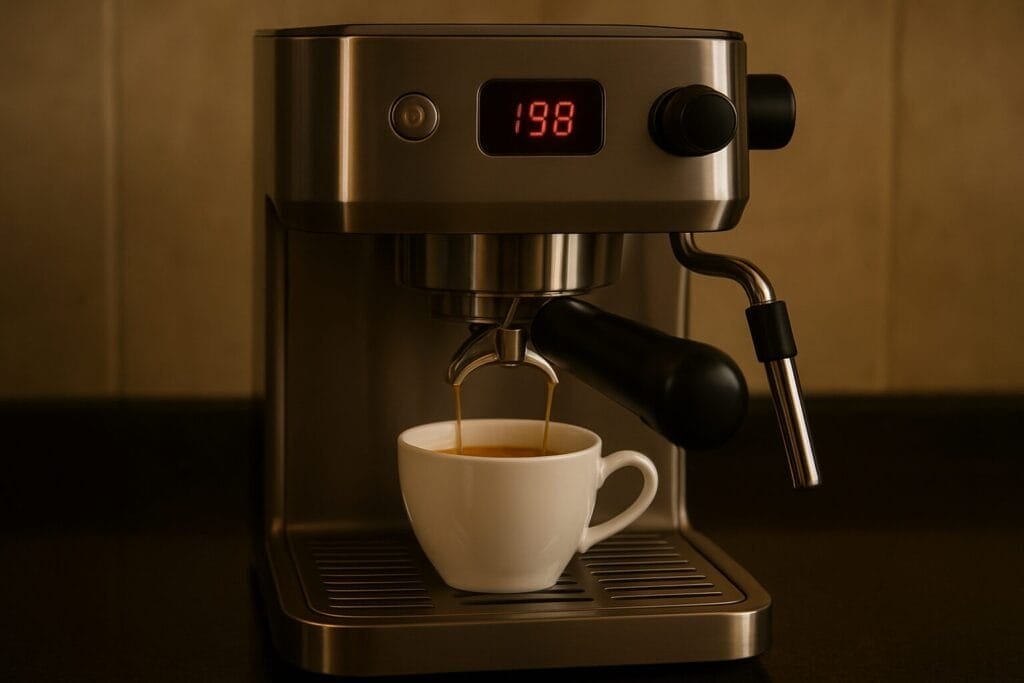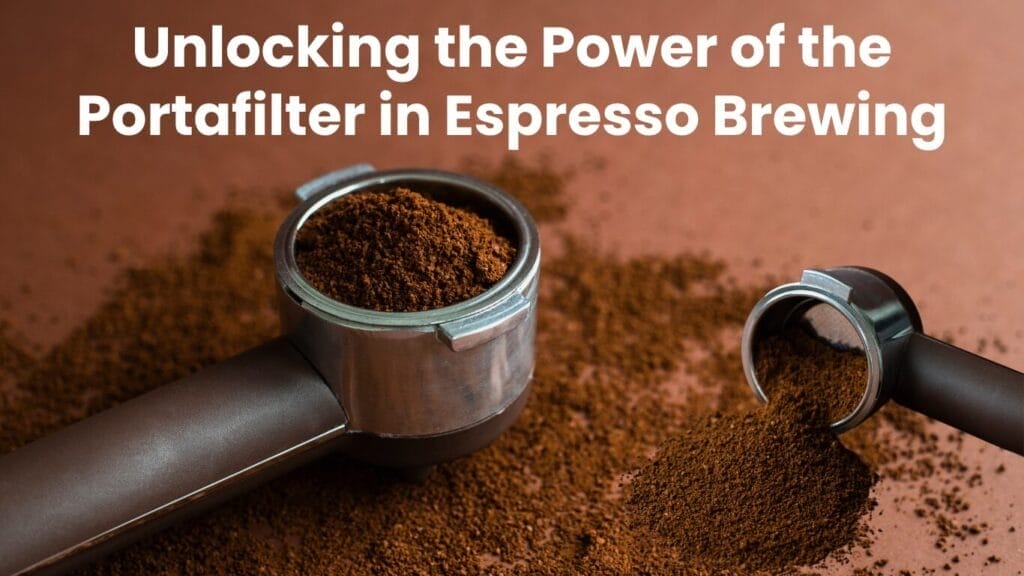Ever wondered what is a portafilter in an espresso machine—and why it’s so essential to that rich, velvety espresso you love?
This small but mighty tool is the secret weapon behind every perfect shot. From locking in pressure to holding your finely ground coffee, the portafilter plays a starring role in transforming simple grounds into café-quality espresso. Whether you’re just getting started or refining your barista skills, understanding the portafilter is the first step to espresso mastery.
Table of Contents
What Is a Portafilter in an Espresso Machine? And Why It Matter
If you’re diving into the world of espresso, one question you’ll quickly run into is: What is a Portafilter in an Espresso Machine?—and why is it so important?
The portafilter might seem like a simple component, but it’s the heart of espresso brewing. It holds your coffee grounds, locks into the machine’s group head, and withstands high-pressure water to produce the rich, intense espresso we all crave.
In short: if your portafilter isn’t doing its job right, your espresso won’t taste right either.
What Exactly Is a Portafilter?

What is a portafilter? In an espresso machine, a portafilter is a metal filter basket enclosed in a robust handle, frequently composed of brass that has been chrome-plated or stainless steel. It’s designed to hold finely ground coffee and secure it firmly in the espresso machine’s group head.
Brewing begins when hot water pushes through the portafilter at about 9 bars of pressure to extract rich espresso.Think of the portafilter as both the stage and the filter for the espresso-making performance. Everything from the grind size to the tamping pressure happens in the portafilter, making it a critical tool in the process.
If you’re getting unpleasant flavors, it may be worth checking why espresso tastes sour or bitteroften caused by tamping errors or grind inconsistency.
For more expert brewing tips and coffee insights, explore our coffee world.
Why Does the Portafilter Matter?
The portafilter directly influences espresso quality. A well-packed, properly sized portafilter creates the right resistance for pressurized water to extract flavor evenly. A poorly packed or incompatible portafilter can lead to over-extraction, under-extraction, or channeling, where water flows unevenly through the coffee.
It’s also responsible for:
- Crema forms as a golden, creamy layer on top of espresso, signaling proper extraction.
- Flow rate control: Dictates how fast or slow the espresso pours.
- Thermal stability: Good portafilters retain heat, improving consistency.
If you notice puddling or moisture buildup, you may want to investigate why machine is leaking, especially near the group head or portafilter gasket..
The Different Types of Portafilters
Not all portafilters are created equal. Here are the main types you’ll encounter:
1. Pressurized Portafilter
Ideal for beginners. It builds extra pressure inside the basket, making it easier to get crema even with inconsistent grind size or tamping. These are often found in entry-level machines.
2. Non-Pressurized (Commercial-Style) Portafilter
Gives the user full control over grind size, tamping, and shot quality. Requires more skill but yields better-tasting espresso. Common in mid-range and high-end home machines.
3. Bottomless (Naked) Portafilter
This type has no spout underneath. It lets you see the shot extracting directly from the basket, perfect for spotting issues like uneven tamping or channeling. Professional coffee makers and skilled users like it.
4. Spouted Portafilter
Includes one or two spouts to guide or split the espresso shot. Standard in commercial settings, especially for making multiple drinks efficiently.
How to Choose the Right Portafilter for Your Machine
When selecting or replacing a portafilter, consider these factors:
- Size Matters: Portafilters come in sizes like 49mm, 51mm, 54mm, and the standard 58mm. Always match the size to your machine.
- Material Quality: Brass retains heat better, while stainless steel is lighter and more affordable.
- Ergonomics: If you’re pulling shots regularly, a comfortable grip can make a big difference.
- Compatibility: Some machines only accept OEM (original equipment manufacturer) portafilters, so check your model’s requirements before buying an upgrade.
- To see compatible tools and accessories for your espresso setup, view espresso gear collection.
Caring for Your Portafilter
Even the best portafilter won’t last if it’s not cleaned and maintained:
- Rinse thoroughly after every shot to remove leftover grounds and oils.
- Soak the metal basket regularly in espresso machine cleaner.
- Avoid using abrasive materials that could scratch the surface or damage the gasket seal.
Understanding What a Portafilter in an Espresso Machine Actually Does
To enjoy great espresso, it helps to understand a key part of the machine: the portafilter. Ever wondered what it actually does? This is where everything becomes clear.
Behind every great espresso shot is a portafilter doing more work than it gets credit for.
It holds the ground coffee, seals into the group head, and allows high-pressure water to flow through the coffee bed, creating the rich, flavorful espresso shot we all love.
Let’s explore each function of the portafilter and how it impacts the final cup.
1. Holds and Secures the Coffee Grounds
The portafilter in an espresso machine contains a removable metal basket where you place your finely ground coffee. This basket is where precise dosing and tamping occur. The quality and evenness of the tamp are essential here—too loose and water flows too quickly; too tight and it chokes the shot.
This step is foundational because how your grounds are distributed and packed inside the portafilter will directly affect the extraction process.
2. Locks Into the Group Head for Sealed Brewing
After the coffee is packed, the portafilter is locked tightly into the group head. This connection is vital—it creates a sealed brewing chamber where pressurized hot water (usually 9 bars) is forced through the coffee puck to produce rich, aromatic coffee from the portafilter machine.
If the seal is weak or the portafilter is misaligned, you can get water leaks, poor pressure, and uneven extraction.
3. Controls Pressure and Water Flow During Extraction
The portafilter isn’t just holding coffee—it’s helping manage flow and pressure dynamics. How the water interacts with the grounds depends on several portafilter variables, including:
- Basket size and shape
- Number of holes underneath
- Spout design (single, double, or bottomless)
A well-built portafilter allows consistent pressure buildup, which leads to proper extraction and the creation of that beautiful crema on top. This is especially important when comparing a 1-bar vs 15-bar espresso machine’s performance.
4. Directly Affects Flavor, Texture, and Consistency
Everything that happens inside the portafilter—from tamping to heat retention—impacts your espresso’s flavor. A cold portafilter can shock the shot, while an uneven puck can cause channeling, leading to bitter or sour notes.
This is why professional baristas often preheat their portafilters and inspect their tamping technique—it’s that crucial to the final taste and texture. It also plays a major role in reaching the correct brew temperature.
5. Interacts with User Skill and Machine Performance
A portafilter is a tool that responds to the barista’s touch. The better your grind size, tamp pressure, and shot timing, the better your espresso. But even the best technique can be compromised if the portafilter is poorly made or dirty.
That’s why understanding its function isn’t just academic—it helps you brew better.
6. Helps Diagnose Brewing Issues
Experienced baristas can often tell what’s going wrong by watching how espresso flows from the portafilter. A bottomless portafilter, for example, allows you to see if the shot is channeling (uneven water paths), spurting, or flowing too fast.
It becomes a diagnostic tool to help you perfect your technique, adjust your grind, or clean your equipment.
Why the Portafilter Is the Heart of Your Espresso Machine
It’s not an exaggeration to say that the portafilter in an espresso machine is where most of the magic happens.

It’s where flavor begins, where pressure builds, and where technique shines. Whether you’re a beginner brewing your first shot or a home barista dialing in your grind, understanding how the portafilter works—and using it well—can mean the difference between a weak shot and an exceptional espresso.
FAQs||What is a portafilter in an espresso machine
What’s the difference between pressurized and non-pressurized portafilters?
Pressurized portafilters help beginners extract crema easily; non-pressurized ones offer full control and require proper grinding and tamping for the best flavor.
Can I use a bottomless portafilter in any espresso machine?
Only if it matches your machine’s size and group head type, typically 58mm for commercial-style machines. Always check compatibility before switching.
Do I need to clean the portafilter in my espresso machine daily?
Yes, clean it after each use to prevent coffee oil buildup, bitterness, and clogging. A clean portafilter ensures consistent espresso quality.
What happens if I tamp incorrectly in a portafilter?
Uneven tamping causes water channeling, leading to sour, bitter, or weak espresso. Consistent tamping ensures even extraction and better flavor.
Does the type of portafilter affect espresso quality?
Absolutely. The portafilter’s size, design, and pressure system directly influence extraction, crema formation, and taste consistency.
Final thought:
In the world of espresso, precision and consistency matter, and the portafilter in an espresso machine is where it all starts. Whether you’re using a pressurized, non-pressurized, or bottomless portafilter, mastering this essential tool unlocks the full potential of your coffee.
From flavor to flow, the portafilter is more than a component—it’s the gateway to café-quality results right from your kitchen. Treat it well, and it will return every shot with excellence, helping you craft the best espresso every single time.







